现代英语词汇学概论chapter1
- 格式:ppt
- 大小:187.00 KB
- 文档页数:21
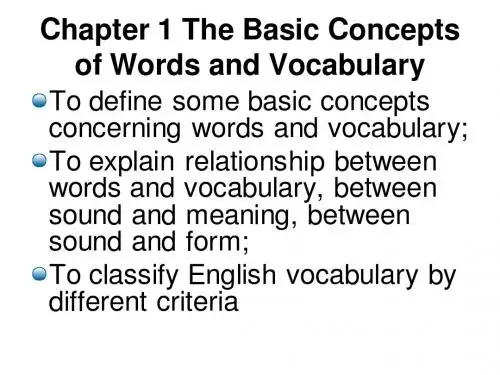
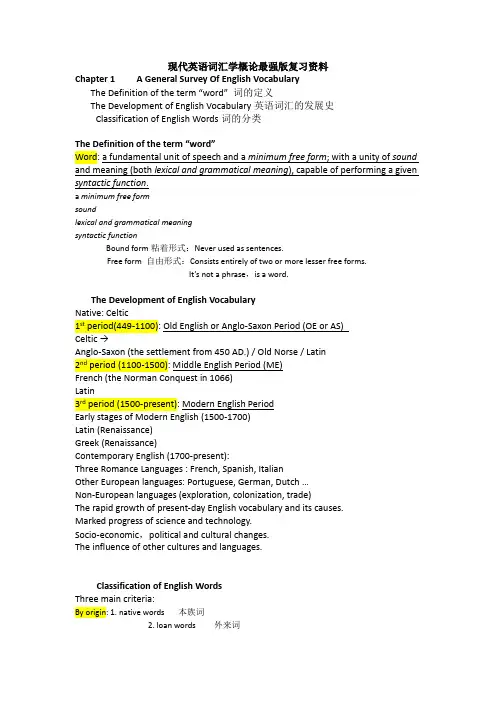
现代英语词汇学概论最强版复习资料Chapter 1 A General Survey Of English VocabularyThe Definition of the term “word” 词的定义The Development of English Vocabulary英语词汇的发展史Classification of English Words词的分类The Definition of the term “word”Word: a fundamental unit of speech and a minimum free form; with a unity of sound and meaning (both lexical and grammatical meaning), capable of performing a given syntactic function.a minimum free formsoundlexical and grammatical meaningsyntactic functionBound form粘着形式:Never used as sentences.Free form 自由形式:Consists entirely of two or more lesser free forms.It’s not a phrase,is a word.The Development of English VocabularyNative: Celtic1st period(449-1100): Old English or Anglo-Saxon Period (OE or AS)Celtic →Anglo-Saxon (the settlement from 450 AD.) / Old Norse / Latin2nd period (1100-1500): Middle English Period (ME)French (the Norman Conquest in 1066)Latin3rd period (1500-present): Modern English PeriodEarly stages of Modern English (1500-1700)Latin (Renaissance)Greek (Renaissance)Contemporary English (1700-present):Three Romance Languages : French, Spanish, ItalianOther European languages: Portuguese, German, Dutch …Non-European languages (exploration, colonization, trade)The rapid growth of present-day English vocabulary and its causes.Marked progress of science and technology.Socio-economic,political and cultural changes.The influence of other cultures and languages.Classification of English WordsThree main criteria:By origin: 1. native words 本族词2. loan words 外来词By level of usage: 1. common words 普通词2. literary words 书面词3. colloquial words 口头词4. slang words 俚语5. technical words 术语By notion: 1. function words 功能词2. content words 实义词By origin:1. native words 本族词2. loan words 外来词Native words: words of Anglo-Saxon origin or of old EnglishFeatures of native words:Most are monosyllabicforming the great majority of the basic word stockLoan / borrowed words: those borrowed from other languagesBasic word stock:auxiliary, modal verbs, numerals, pronouns, prepositions, conjunctions, the most frequently used words (essential to life)National characterStabilityWord-forming abilityAbility to form collocationsBy level of usage:1. Common words 普通词2. Literary words 书面词3. Colloquial words 口头词4. Slang words 俚语5. Technical words 术语*There are no clear-cut boundaries between the various classes of words.Common words普通词:connected with the ordinary things or activities necessary to everyday lifeThe core of the common words is the basic word stock.Stylistically neutralLiterary words书面词:chiefly used in writing, especially in books written in a more elevated style, in official documents, or in formal speeches.Most are of French, Latin or Greek origin.Among the literary word, two categories are noteworthy:archaic words . obsolete words)poetical wordsSlang俚语:Language, words or phrases of a vigorous, colorful, facetious, or taboo nature, invented for specific occasions, or uses or derived from the unconventional use of the standard vocabularyNot generally used in informal conversation unless the speakers are on intimate termsEmbracing those daring and new expression that have not been accepted as standard EnglishThe chief reason for use of slang: secure freshness and noveltyTechnical words术语:used in various fields: science, profession or trade, art, sportincreasing precision in nomenclatureone specific meaningLatin or Greek in originBy notion:1. function words 功能词2. content words 实义词Function words:determiners, conjunctions, prepositions, auxiliariesnot having much lexical meaningserving grammatically:Behaving like grammatical signals or functional markers,Expressing the kinds of connection between content wordsConstructing acceptable English sentencessmall in number and stable:In relatively closed listsBelonging to a relatively small and permanent set of words)high frequency。
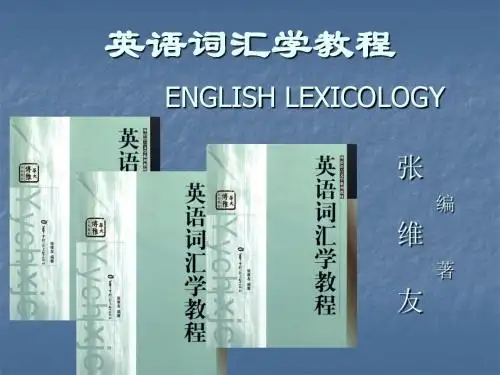
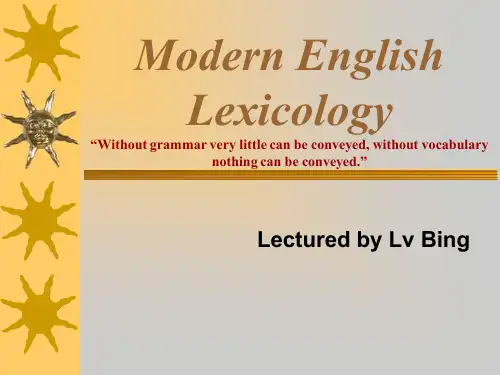
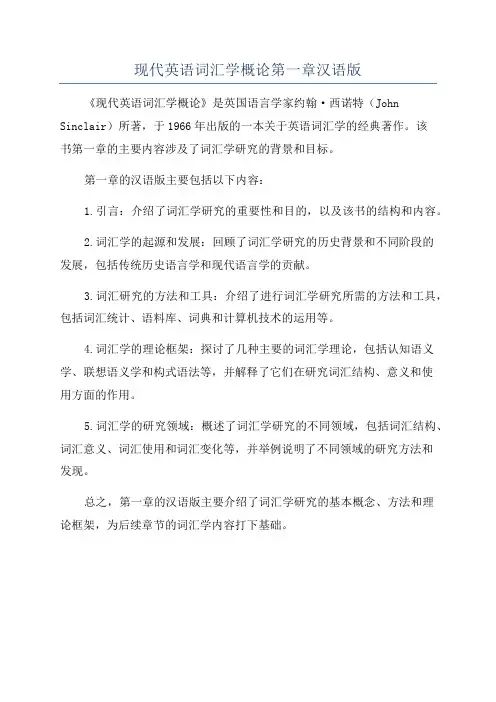
现代英语词汇学概论第一章汉语版
《现代英语词汇学概论》是英国语言学家约翰·西诺特(John Sinclair)所著,于1966年出版的一本关于英语词汇学的经典著作。
该
书第一章的主要内容涉及了词汇学研究的背景和目标。
第一章的汉语版主要包括以下内容:
1.引言:介绍了词汇学研究的重要性和目的,以及该书的结构和内容。
2.词汇学的起源和发展:回顾了词汇学研究的历史背景和不同阶段的
发展,包括传统历史语言学和现代语言学的贡献。
3.词汇研究的方法和工具:介绍了进行词汇学研究所需的方法和工具,包括词汇统计、语料库、词典和计算机技术的运用等。
4.词汇学的理论框架:探讨了几种主要的词汇学理论,包括认知语义学、联想语义学和构式语法等,并解释了它们在研究词汇结构、意义和使
用方面的作用。
5.词汇学的研究领域:概述了词汇学研究的不同领域,包括词汇结构、词汇意义、词汇使用和词汇变化等,并举例说明了不同领域的研究方法和
发现。
总之,第一章的汉语版主要介绍了词汇学研究的基本概念、方法和理
论框架,为后续章节的词汇学内容打下基础。
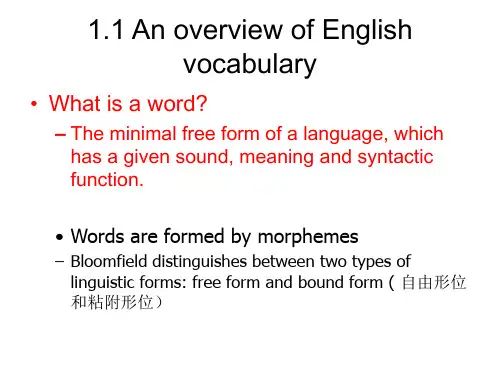
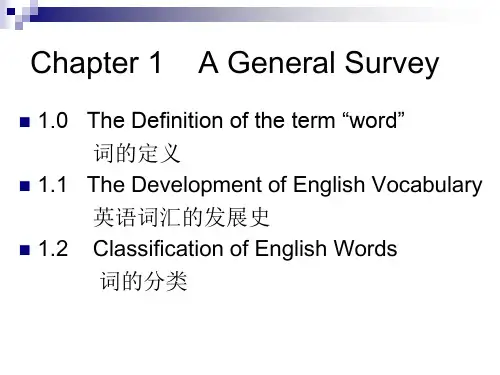
![英语词汇学第一章[文字可编辑]](https://uimg.taocdn.com/9cff9d9b76eeaeaad1f3304f.webp)
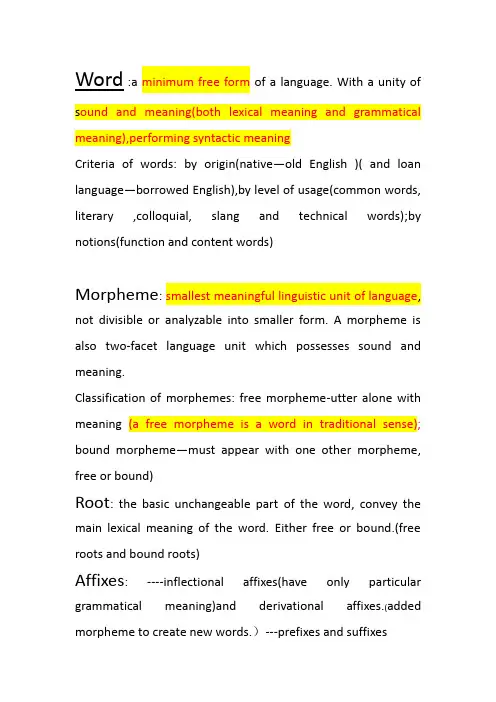
Word :a minimum free form of a language. With a unity of s ound and meaning(both lexical meaning and grammatical meaning),performing syntactic meaningCriteria of words: by origin(native—old English )( and loan language—borrowed English),by level of usage(common words, literary ,colloquial, slang and technical words);by notions(function and content words)Morpheme: smallest meaningful linguistic unit of language, not divisible or analyzable into smaller form. A morpheme is also two-facet language unit which possesses sound and meaning.Classification of morphemes: free morpheme-utter alone with meaning(a free morpheme is a word in traditional sense); bound morpheme—must appear with one other morpheme, free or bound)Root: the basic unchangeable part of the word, convey the main lexical meaning of the word. Either free or bound.(free roots and bound roots)Affixes: ----inflectional affixes(have only particular grammatical meaning)and derivational affixes.(added morpheme to create new words.)---prefixes and suffixesWord-formationThree major processes : compounding(joining tow or more bases to form a new unit of compound words)Derivation(forming a new word by addition of a word element)Conversion(a word of certain word-class is shifted into another word-class without any affixes)Eight minor processes :Acronymy (Initialisms –using the first letter from proper name ,phrase, technical words)Ainitialism is pronounced letter by letter) and acronyms—from the initial letters of the name of an organization or scientific term)==are pronounced as words.Clipping(deletion of one or more syllables from a word—usually a noun, which is also available in its full form)Classification—back clipping, front clipping ,front and back clipping and phrase clipping.)Blending---formed by combining the meanings and sound of tow words.one of which is not full form or both of which are not full form. )不完整拼缀Back-formation(coined by the deletion of a supposed affix from a longer form already present in the language.)Words from proper names(including names of scientists, names of politicians and statesman, names of places, trademark, literature)Reduplication(a compound word is created by the repetition(1)of one word like go-go(2)almost identical words with a change in the vowel’s such as ping-pong.(3)of two almost identical words with a change in the initial consonants ,as in teenyweeny.Neoclassical(new words are formed from elements derived from Latin and Greek)The majority of neoclassical formations are scientific and technical.MiscellaneousWord meaning and sense relations1,conventionality—no way to explain why this or that sound-symbol and its sense.2,motivation—phonetic ,morphological, sematic3,main types of word meaning(interrelated andinterdependent)---class and inflectionalparadigm)andmeaning; connotative meaning—emotional association; social or stylistic meaning and affective meaning)Binary opposites.二相对立Polysemy—a term used in sematic analysis to refer to lexical item which has a range of meanings.)T wo approaches—diachronic and synchronic.---primary meaning and derived meaning, central meaning and secondary meaning(in some cases, the primary meaning and the central meaning coincide.)Two processes leading to polysemy---radiation(each of the secondary meanings may become a center of further radiation),concatenation(linking together, like the links of a chain.Homonymy(---pronounced alike, spell alike, or both.)---types of homonyms(perfect homonyms—word identical in sound and spelling but different in meaning)(Homophones---identical in sound but different in spelling and meaning.)(Homographs—identical in spelling but different in sound and meaning.)Polysemic and homonymous words are stylistically useful to achieve humour or irony, or to heighten dramatic effect. Synonymy(—identical in meaning but different in sound and spelling.)--- Complete synonyms(absolute),Relative synonyms.Antonymy (--opppsiteness of meaning)---contrary, complementary and conversives ….Antonyms classified on the basis of morphological structure: root antonyms and derivational antonyms.Marked and unmarked words---subsume.(Marked members can not be used to include unmarked member.) Hyponymy—(relationship which obtains specific and general lexical items)Superordinate term(an upper term),Subordinate terms(a lower term)===hierarchical system Sematic field---is not simply a listing of independent items, organized into areas or field.Charateristic of the same sematic field.1),word frequency in the same semantic varies 2)these words are semantically interdepent.3) words in the same semantic field are likely to have a number of collocation on common. Changes in word meaning---1,causes:historical,social,foreign influence, linguistic and psychological .2, Four tendencies in sematic change---restriction, extension, degeneration, elevation (of meaning)具体化,普遍化,语义转贬,语义改良。
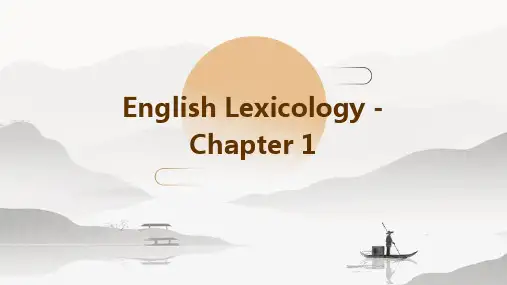
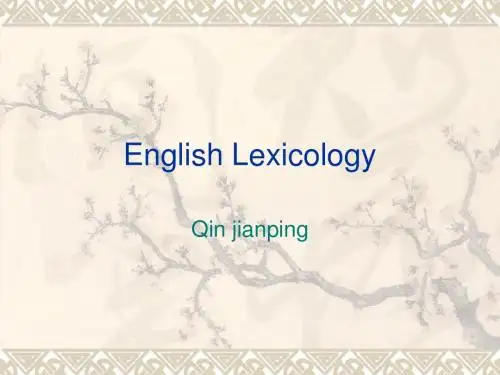
张韵斐著《现代英语词汇学概论》——解析第一部分Chapter Ⅰ英语词汇的概论 (A general survey of English vocabulary)Bloomfield 1933中对词的定义是,每个单词都是最小的自由词。
然而这个定义不够全面,存在着缺陷。
首先,不是所有的单词都可以独立出现,如the ,a , my 这些单词单独出现则没有具体意义。
另外, Bloomfield的定义侧重在于语法(syntax )却没有涉及到词的意义。
随着词汇学的发展跟完善。
人们给词下了较为完整的定义。
“词,今指语言组织中的基础单位,能独立运用,具有声音、意义和语法功能。
”(《辞海》 1984 (上) 375 页,上海辞书出版社)一种语言中所有的单词汇集起来便构成了该语言的词库。
纵观英语的发展历史,我们可以知道,大多数的英语词汇都是外来词,它从拉丁语,法语和希腊语等语言中汲取词汇,不断的扩充自己,为己所用。
特别是第二次世界大战之后,英语词汇得到了空前的发展。
现代英语词汇快速发展的原因主要有四方面。
一是科学技术的快速发展,二是社会经济的全球化,三是英语国家的政治和文化变化,最后是其他文化和语言对英语的强烈影响。
英语词汇是由各种不同类型的单词组成,而这些单词有着不同的分类标准。
根据词的起源可以分为本族语和外来语;根据使用水平可以分为普通词汇,文学词汇。
口头词汇,俚语以及科学术语。
基础语库的基本特征是具有民族特征,稳定性,构词的能力和搭配能力。
第二部分 Chapter Ⅱ到 Chapter Ⅳ(Morphological structure of English words and英语词汇的形态结构和词的构词word-formation )(一 ) 词素( Morphemes)单词是有词素(morphemes)构成的。
词素即英语语言中有意义的最小单位,同时具有声音和意义。
单词可以有一个或一个以上的词素组成。
如:nation 是一个词素,national 有 nation+al两个词素。